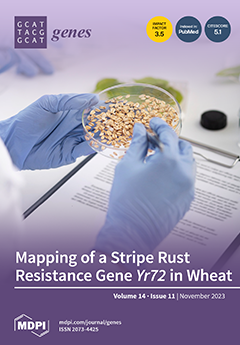Plant-specific YABBY transcription factors play an important role in lateral organ development and abiotic stress responses. However, the functions of the
YABBY genes in quinoa remain elusive. In this study, twelve
YABBY (
CqYAB) genes were identified in the quinoa genome, and
[...] Read more.
Plant-specific YABBY transcription factors play an important role in lateral organ development and abiotic stress responses. However, the functions of the
YABBY genes in quinoa remain elusive. In this study, twelve
YABBY (
CqYAB) genes were identified in the quinoa genome, and they were distributed on nine chromosomes. They were classified into FIL/YAB3, YAB2, YAB5, INO, and CRC clades. All
CqYAB genes consist of six or seven exons, and their proteins contain both N-terminal C2C2 zinc finger motifs and C-terminal YABBY domains. Ninety-three
cis-regulatory elements were revealed in
CqYAB gene promoters, and they were divided into six groups, such as
cis-elements involved in light response, hormone response, development, and stress response. Six
CqYAB genes were significantly upregulated by salt stress, while one was downregulated. Nine
CqYAB genes were upregulated under drought stress, whereas six
CqYAB genes were downregulated under cadmium treatment. Tissue expression profiles showed that nine
CqYAB genes were expressed in seedlings, leaves, and flowers, seven in seeds, and two specifically in flowers, but no
CqYAB expression was detected in roots. Furthermore,
CqYAB4 could rescue the
ino mutant phenotype in
Arabidopsis but not
CqYAB10, a paralog of
CqYAB4, indicative of functional conservation and divergence among these
YABBY genes. Taken together, these results lay a foundation for further functional analysis of
CqYAB genes in quinoa growth, development, and abiotic stress responses.
Full article






